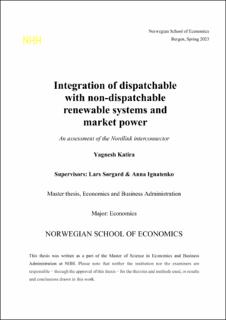Integration of dispatchable with non-dispatchable renewable systems and market power : An assessment of the Nordlink interconnector
Master thesis
Permanent lenke
https://hdl.handle.net/11250/3090850Utgivelsesdato
2023Metadata
Vis full innførselSamlinger
- Master Thesis [4372]
Sammendrag
An increase in integration of electricity markets is allowing for a frequent collaboration
between dispatchable and non-dispatchable technologies. The dispatchable nature of the
former technology creates a potential for market power amongst firms that host dispatchable
technology. As Europe is increasingly embracing non-dispatchable renewables like wind and
solar for power generation, it is crucial to address this issue in the presence of dispatchable
hydropower systems in the Nordics. A market power analysis has become imperative ever
since the NordLink interconnector was opened between hydro-rich Norway with Germany
that has enormous share of renewables in its generation mix. My thesis therefore attempts to
empirically contribute to the limited literature that has so far addressed this concern but is
surely gathering pace. Relying on the theoretical findings from Brekke et al. (2022) and other
limited literature on this aspect, I find evidence of non-competitive behaviour by Norwegian
hydropower firms in NO2 area after the interconnector was commissioned. By compiling a
rich dataset at hourly frequencies, I could show that gaining pivotal status even for shorter
time-period has encouraged firms to engage in non-competitive behaviour. The thesis further
compares such behaviour during both pre-NordLink and post-NordLink period and finds key
differences in the patterns. Whereas a long-run seasonal price elasticity drove such behaviour
earlier, pivotal firms engaged in peculiar short-run as well as long-run non-competitive
behaviour concurrently. This new-found short-run behaviour was influenced by variations in
prevailing German power prices while the long-run behaviour was induced by an interplay of
erstwhile seasonal effect as well as a long run price effect. This long-run price effect is
collective influenced by current and future price expectations in Germany and variation in
available water endowments. My study is finally made robust by demonstrating a stronger
impact of non-competitive behaviour on market outcomes in the post-NordLink regime as
compared to pre-NordLink period by a factor of three. After the connection, the market power
behaviour contributed significantly to price rise despite the presence of other factors driving
German prices. This bodes well with the theoretical findings of Brekke et al. (2022) that
attributes presence of non-competitive behaviour in Norway that does not allow high price
variations that generate in Germany to smoothen as they propagate into Norwegian electricity
markets due to integration.
